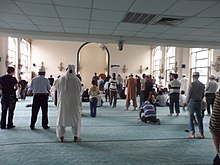Qiyam
This article needs additional citations for verification. (May 2020) |

Qiyām (
In the Quran
To "stand before God" is sometimes used in the Quran in reference to the Islamic prayer.
Guard strictly your (habit of) prayers, especially the Middle Prayer; and stand before Allah in a devout (frame of mind).
— Quran, (2:238)
Overview
A general unit or cycle of salah called
I'tidāl is straightening up from
Types of prayers
In the five daily prayers,
In
ritual, the entire prayer consists of qiyām.Sayings during qiyām
Most of the reciting of the Quran that occurs during Islamic prayer is done while in qiyām. The first chapter of the Quran, Al-Fatiha, is recited while standing.[1][2] Sahih Muslim recorded that Abu Hurayrah said that Muhammad said, «مَنْ صَلَى صَلَاةً لَمْ يَقْرَأْ فِيهَا أُمَّ الْقُرْآنِ فَهِيَ خِدَاجٌ ثَلَاثًا غَيْرُ تَمَامٍ» (Whoever performs any prayer in which he did not read Umm Al-Qur'an, then his prayer is incomplete.)
Additionally, recitations from any other section from the Quran of choice is followed in the first or second raka’ah.[1][2]
Position of hands in qiyām
Where the hands are placed in qiyām varies among the different Islamic schools and branches.[3] These differences have manifested into the qabd-sadl dispute. Among Sunnis, several hadith indicate that qabd (praying with arms crossed) is desirable, if not obligatory; however, sadl (arms hanging by the sides) is still preferred among many Malikis.[4] The debate predominantly exists in Maliki-practicing areas, such as Northern Nigeria, due to the influence of other Sunni schools.[5][6]
Sunni view
Hanafi
For
Maliki
Unique among
Shafi'i
Hanbali
Hanbalis can put their hands either below the navel like Hanafis, or above the navel like Shafi’is.
Salafi view
Majority of Salafis place the right hand over the left hand over the chest, but Salafis are not restricted to one particular way, so different Salafis can follow the way of Hanbalis, Hanafis, Shafi'is, and Malikis.[citation needed]
Shia view
Twelver Shia
Zaydi Shia
Ibadi view
Just like Shia Muslims and Maliki Sunnis,
Straightening prayer rows
A number of ahadith exist regarding the need to straighten the rows when standing during the prayer.[10] For example, the companion Anas relates that Muhammad said: "Stand close together in your rows, keep them near each other and stand neck to neck. By Him in whose hand is my life, I see the devil entering between the gaps as do the small lambs."[11][12]
Similarly, Abu Umamah relates Muhammad saying: "Straighten your rows, stand shoulder to shoulder, be soft upon your brother and fill the gaps, for the devil enters through the gaps like the small lambs."[13][12]
See also
References
- ^ ISBN 9780199862634.
- ^ a b c d e f Shaikh Muhammad Ilyas Faisal, "Sifatus Salat: The Method of Salat in Light of the Authentic Ahadith." Madinat al-Munawwara. 08, October 2014.
- ISBN 9780253007971.
- ISBN 9781107040571.
- ISBN 9782845866157.
- ISBN 9780810128101.
- ^ Sharh e Muslim, volume 1, page 590, by Allama Ghulam Rasool Sa’eedi, Lahore
- ISBN 9789783091078.
- ISBN 9789004289468.
- ISBN 9780199862634.
- ^ Abu Dawud, no.667; al-Nasa’i, no.814, with a sahih chain. al-Nawawi, al-Majmu‘ Sharh al-Muhadhdhab (Beirut: Dar al-Fikr, 2000), 4:227; al-Arna’ut, Sunan Abi Dawud (Damascus: Dar al-Risalah al-‘Alamiyyah, 2009), 2:9.
- ^ a b c Abu Aaliyah, "Joining Feet to Straighten Prayer-Rows: Is it a Sunnah?" 15 March 2016
- ^ Ahmad, Musnad, no.21760. It was confirmed as authentic (sahih) in al-Albani, Sahih al-Jami‘ al-Saghir (Beirut: al-Maktab al-Islami, 1986), no.1840.
- ^ Nayl al-Awtar (Riyadh: Dar Ibn al-Jawzi, 2006), 6:113.
